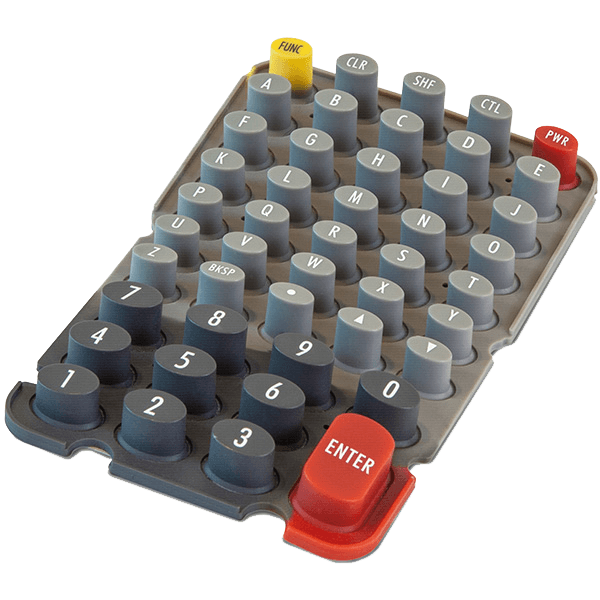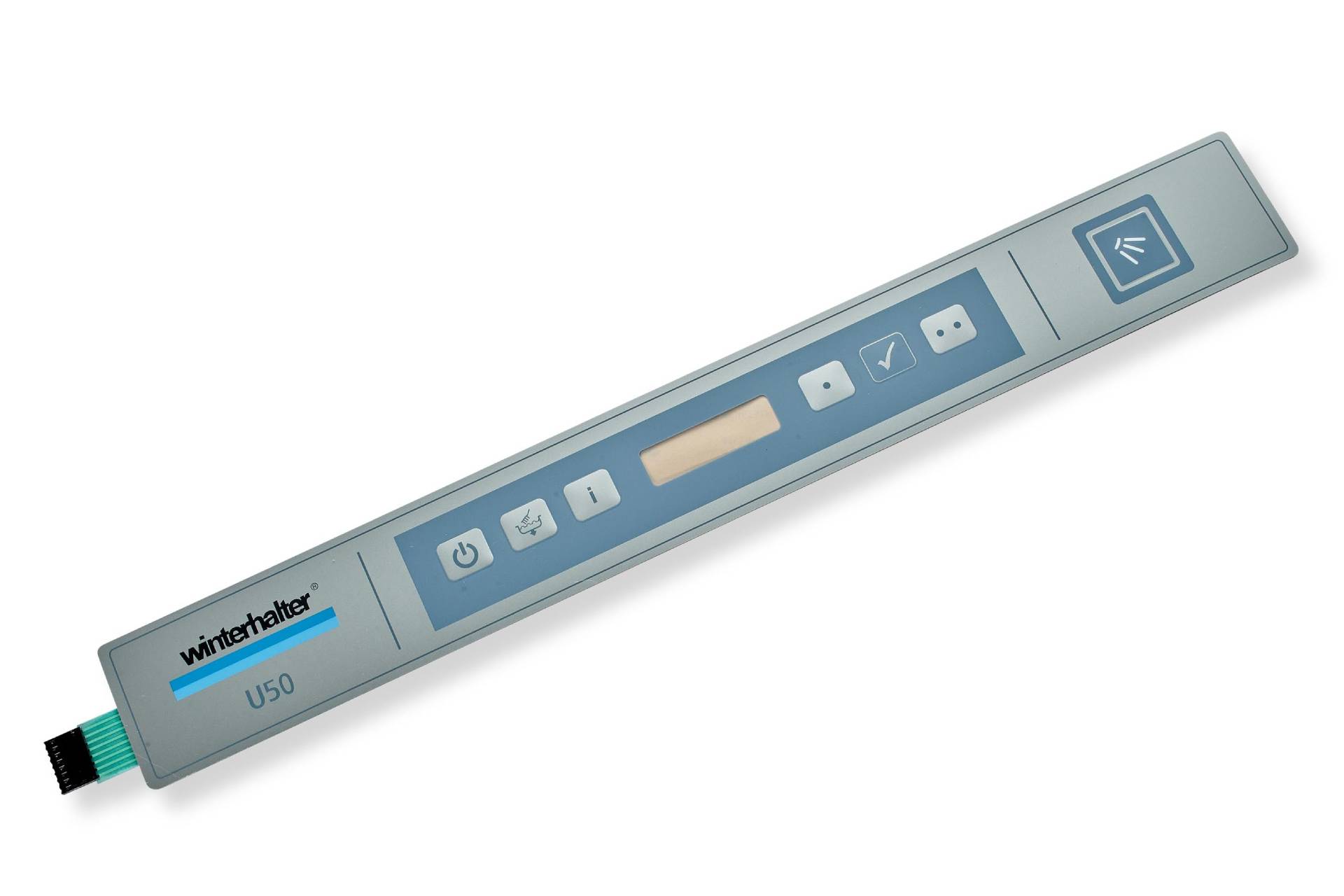The environmental impact of producing Rubber Keypads and sustainable alternatives
A Comprehensive Guide to the Manufacturing and Processing of Rubber Keypads for Optimum Efficiency
The production and processing of rubber keypads play an essential duty in their efficiency and usability. Product selection, layout precision, and sophisticated manufacturing techniques substantially affect their resilience and effectiveness. Recognizing these elements is essential for producing high-quality products. As different innovations emerge in this field, discovering their effects might reveal new requirements for performance and user experience. What essential facets will form the future of rubber keypads?
Understanding Rubber Keypads: Products and Types
Rubber keypads are important parts in countless gadgets, offering a balance of toughness and tactile responses. These keypads are primarily made from silicone or synthetic rubber, products selected for their versatility and durability. Silicone rubber, particularly, is preferred for its excellent temperature level resistance and long life, making it optimal for different applications, from consumer electronic devices to commercial equipment.
There are several types of rubber keypads, consisting of dome button keypads, which utilize a dome-shaped system that supplies responsive responses when pressed. Furthermore, there are additionally flat keypads, which feature a smooth surface area and are frequently made use of in medical gadgets and remote controls. The selection of material and type influences the keypad's performance, feel, and general user experience. Understanding these elements is important for developers and makers aiming to create effective and reputable user interfaces in their items.
The Production Process: From Style to Manufacturing
The manufacturing process of rubber keypads includes a number of important stages, beginning with design and finishing with manufacturing. Originally, developers create in-depth requirements and prototypes, ensuring the keypad satisfies functional and visual demands. Computer-aided design (CAD) software is frequently used to imagine the layout and attributes before continuing.
Once the design is settled, product choice is important, with options usually including silicone or all-natural rubber. In the following stage, mold and mildews are developed based upon the accepted styles, which will shape the keypads throughout production.
Following mold production, the production phase begins, where rubber is combined with ingredients to enhance efficiency. The mixture is after that poured into mold and mildews and subjected to warmth and pressure, permitting it to cure and strengthen.
Ultimately, the finished keypads go through quality checks to validate they satisfy well-known standards, complied with by packaging for circulation. This all-encompassing procedure warranties peak efficiency in the final product.
Trick Strategies in Rubber Molding
In the domain name of rubber keypads, different molding strategies play a crucial role in establishing the high quality and capability of the final item. One prevalent method is compression molding, where raw rubber is put in a warmed mold and pressure is applied, enabling effective mass manufacturing and uniformity. An additional significant method is shot molding, which involves injecting heated rubber into a mold, providing higher precision and complex forms. Transfer molding, a hybrid of both approaches, is also utilized, especially for elaborate layouts, as it combines the advantages of both procedures. Furthermore, fluid silicone rubber (LSR) molding is obtaining traction because of its flexibility and toughness, making it excellent for high-performance applications. Each technique has distinct characteristics, influencing elements such as cycle time, material waste, and manufacturing expenses. Selecting the suitable molding method is necessary for attaining peak efficiency in rubber keypads.
Surface Area Finishing and Texturing Options
Surface completing and texturing alternatives play a crucial role in improving the responsive experience and aesthetic appeal of rubber keypads. Makers use different techniques to produce distinctive surface area features that affect user communication and product design. Usual completing methods include matte, shiny, and satin finishes, each using different aesthetic results and grip degrees. Texturing alternatives, such as raised patterns, grooves, or stippling, further improve functionality by boosting traction and reducing slippage during usage.
In addition, certain textures can be customized to satisfy ergonomic needs, giving comfort during prolonged use. The option of surface finishes and appearances can be affected by the intended application of the keypad, whether it be for customer electronic devices, automotive controls, or industrial gadgets. Ultimately, cautious factor to consider of these options adds considerably to customer contentment and overall item efficiency, making them important components in the layout and production process of rubber keypads.
Quality Assurance Measures in Rubber Keypad Production
Quality assurance actions in rubber keypad manufacturing are essential for guaranteeing item integrity and performance. These actions incorporate material selection standards, extensive screening procedures, and rigorous final inspection standards. With each other, they create a comprehensive structure that aids suppliers maintain read this post here top quality throughout the manufacturing process.

Product Choice Standards
Choosing the proper materials for rubber keypads is necessary, as it straight affects their performance, user, and resilience experience. Secret standards for product option include tensile strength, strength, and environmental resistance. The option of rubber compound, such as silicone or polycarbonate elastomer (TPE), plays an essential role in achieving desired responsive comments and long life. Additionally, aspects like chemical compatibility, temperature security, and UV resistance should be considered to guarantee optimal performance in different applications. Producers must additionally evaluate the convenience of handling and cost-effectiveness of products, balancing top quality with budget restraints. Ultimately, the best material selection not only boosts the keypad's efficiency yet also adds to total product quality and consumer complete satisfaction.
Evaluating Procedures Carried Out
After figuring out the appropriate materials for rubber keypads, rigorous screening treatments are implemented to confirm that the end products satisfy sector criteria and consumer assumptions. These procedures typically consist of mechanical testing, which reviews the toughness and flexibility of the rubber under numerous conditions. Additionally, ecological testing examines the keypads' performance under temperature changes, moisture, and direct exposure to chemicals. Electrical testing validates the keypads work properly with electronic components, validating responsiveness and conductivity. Additionally, responsive feedback is assessed to assure individual fulfillment. These substantial screening actions are essential in determining any type of problems or incongruities before mass production, inevitably improving the reliability and performance of rubber keypads in their desired applications.

Last Inspection Specifications
Detailed last assessment requirements are vital in rubber keypad click now manufacturing to ensure that each system satisfies the specified standards for performance and appearance. This procedure typically entails aesthetic evaluations to recognize any type of surface area flaws, such as staining or imperfections. Furthermore, responsive evaluations ascertain that the keypads react precisely to touch, maintaining the called for level of level of sensitivity. Durability tests might likewise be carried out, simulating extended usage to confirm the long life of the keypad under numerous conditions. Furthermore, adherence to market policies and customer requirements is verified to maintain quality assurance. By applying these strenuous inspection procedures, producers can substantially reduce the risk of problems, making certain that the end product is trustworthy and fulfills consumer assumptions, eventually enhancing customer satisfaction.
Advancements in Rubber Keypad Modern Technology
As technology remains to progress, developments in rubber keypad innovation are reshaping interface throughout different industries. One substantial improvement is the assimilation of capacitive touch sensing units within rubber keypads, enabling an extra responsive and versatile individual experience. This technology enables individuals to engage with devices with touch, improving functionality without giving up the tactile comments that rubber keypads are understood for.
In addition, improvements in material solutions have actually led to the development of even more resilient, weather-resistant rubber, making keypads ideal for exterior and commercial use. Enhanced printing strategies additionally permit high-resolution graphics and backlighting alternatives, raising visibility and aesthetic appeal.

Improvements in producing procedures, such as 3D printing, are making it possible for personalized layouts and quick prototyping, simplifying production timelines. These developments jointly contribute to extra efficient and user-friendly rubber keypads, ensuring they meet the demands of modern applications while maintaining their core advantages.
Ideal Practices for Layout and Capability
Creating efficient rubber keypads needs cautious assessment of both visual appeals and capability. Rubber Keypads. A properly designed keypad ought to stabilize ergonomic concepts with aesthetic attract improve individual experience. Key variables include dimension, form, and spacing of switches, ensuring they are very easy to press while avoiding accidental activation. Using contrasting structures and colors can enhance exposure and responsive comments, helping users in differentiating in between secrets
Furthermore, the selection of materials plays an essential role; high-grade rubber compounds can enhance resilience and resistance to put on. It is additionally crucial to think about the assimilation of attributes such as backlighting and personalized graphics, which can enhance functionality in numerous environments.
Prototyping and individual screening are very useful in the style procedure, enabling for modifications based on real-world responses. By sticking to these ideal techniques, producers can produce rubber keypads that not just look appealing but also satisfy the practical demands of users properly.
Frequently Asked Questions
How Do I Pick the Right Rubber Product for My Keypad?
To pick the appropriate rubber product for a keypad, one ought to think about variables such as longevity, ecological resistance, tactile responses, and compatibility with the desired application, guaranteeing suitable performance and individual contentment in various conditions.
What Are the Environmental Influences of Rubber Keypad Production?
Rubber keypad manufacturing can lead to environmental influences such as deforestation for natural rubber sources, air pollution from chemical procedures, and waste generation. Lasting techniques and products can reduce some of these adverse results on ecological communities.
Can Rubber Keypads Be Recycled or Recycled?
Rubber keypads can be recycled, yet the process depends on the certain products utilized in their production. Recycling them in various applications is also feasible, adding to lose reduction and promoting sustainability in manufacturing techniques.
What Is the Ordinary Life-span of a Rubber Keypad?
The typical lifespan of a rubber keypad generally ranges from 5 to one decade, depending on use, ecological elements, and upkeep. Regular treatment can extend its capability, while extreme wear may reduce its sturdiness.
Are There Any Type Of Wellness Worries Connected To Rubber Keypad Materials?
There are potential health and wellness concerns connected to rubber keypad products, consisting of allergic reactions to particular chemicals and toxic irritants used in manufacturing. Correct handling and understanding of material make-up can alleviate these risks for individuals.
There are a number of kinds of rubber keypads, including dome button keypads, which utilize a dome-shaped device that offers tactile responses when pushed. Picking the proper materials for rubber keypads is essential, as it straight affects their capability, user, and toughness experience - Rubber Keypads. After establishing the suitable products for rubber keypads, rigorous screening treatments are executed to validate that the final products satisfy industry requirements and client assumptions. Rubber keypad manufacturing can lead to environmental impacts such as logging for all-natural rubber resources, pollution from chemical processes, and waste generation. Rubber keypads can be recycled, however the process depends on the details products utilized in go to this website their production